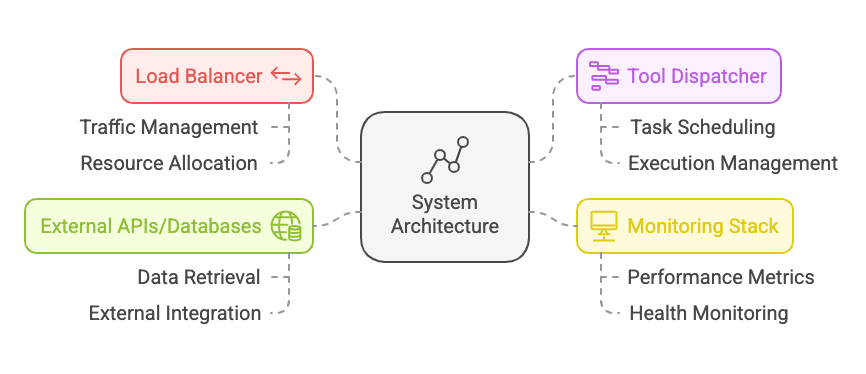Tool calling is more than just a technical feature—it’s a critical enabler for building scalable, secure, and highly reliable systems powered by Large Language Models (LLMs). This article delves into advanced production strategies, including error recovery, observability, scalability, and diverse real-world applications.

2. Advanced Error Recovery Mechanisms
2.1 Retry Strategies
Retries are essential for handling transient errors during tool execution. Use structured retry strategies to improve reliability without overloading the system.
Exponential Backoff Example
import asyncio
async def retry_with_backoff(func, retries=3, backoff=2):
for attempt in range(retries):
try:
return await func()
except Exception as e:
if attempt < retries - 1:
await asyncio.sleep(backoff ** attempt)
else:
raise e2.2 Fallback Mechanisms
Fallbacks are used when primary tools fail to ensure graceful degradation.
Fallback Example
def fetch_data_with_fallback(primary_tool, fallback_tool, parameters):
try:
return primary_tool.execute(parameters)
except ToolExecutionError:
return fallback_tool.execute(parameters)2.3 Intelligent Error Categorization
Not all errors require the same response. Categorize errors to define tailored handling strategies.
| Error Type | Response Strategy |
|---|---|
| TimeoutError | Retry with exponential backoff |
| ValidationError | Log and notify developers |
| RateLimitExceededError | Delay and retry |
| ToolDependencyFailure | Trigger fallback mechanism |
3. Comprehensive Observability
Observability ensures that the tool-calling infrastructure is transparent, traceable, and responsive to failures.
3.1 Metrics
Track key metrics like:
- Success rates
- Latency
- Error rates
- Tool usage frequency
Prometheus Integration Example
from prometheus_client import Counter, Histogram
execution_count = Counter(
'tool_execution_total', 'Number of tool executions', ['tool_name', 'status']
)
execution_latency = Histogram(
'tool_execution_latency', 'Tool execution latency', ['tool_name']
)
def record_execution(tool_name, latency, status="success"):
execution_count.labels(tool_name, status).inc()
execution_latency.labels(tool_name).observe(latency)3.2 Distributed Tracing
Use tracing frameworks to trace requests across distributed systems.
OpenTelemetry Example
from opentelemetry import trace
tracer = trace.get_tracer(__name__)
def execute_tool(tool_name, parameters):
with tracer.start_as_current_span(f"execute_{tool_name}") as span:
span.set_attribute("tool.parameters", parameters)
result = tool_registry.execute(tool_name, parameters)
span.set_attribute("tool.result", result)
return result3.3 Alerts and Dashboards
Set up alerts for key conditions like high error rates or slow execution times. Use dashboards to visualize performance.
4. Scalability Strategies
4.1 Horizontal Scaling
Distribute tool execution across multiple nodes for scalability.
Kubernetes Deployment Example
apiVersion: apps/v1
kind: Deployment
metadata:
name: tool-calling-service
spec:
replicas: 5
selector:
matchLabels:
app: tool-calling
template:
metadata:
labels:
app: tool-calling
spec:
containers:
- name: tool-service
image: tool-calling-service:latest
ports:
- containerPort: 80804.2 Caching for High-Throughput Systems
Caching reduces redundant computations and API calls.
Redis Cache Integration Example
import redis
import hashlib
redis_client = redis.Redis()
def execute_with_cache(tool_name, parameters):
cache_key = hashlib.sha256(f"{tool_name}{parameters}".encode()).hexdigest()
cached_result = redis_client.get(cache_key)
if cached_result:
return cached_result
result = tool_registry.execute(tool_name, parameters)
redis_client.set(cache_key, result, ex=300) # Cache for 5 minutes
return result
4.3 Load Balancing
Use load balancers to evenly distribute requests.
HAProxy Configuration
frontend tool_api
bind *:8080
default_backend tool_backends
backend tool_backends
balance roundrobin
server node1 10.0.0.1:8081 check
server node2 10.0.0.2:8081 check5. Real-World Applications
5.1 Customer Support Chatbots
Integrate customer databases and contextual knowledge bases for dynamic support.
Example: Fetching User Order History
def fetch_order_history(user_id):
# Simulate fetching from a database
return {"user_id": user_id, "orders": [{"id": 1, "item": "Laptop", "status": "Shipped"}]}
5.2 Financial Trading Bots
Query live stock APIs and provide real-time analytics.
Example: Stock Analysis Tool
def analyze_stock(symbol):
# Simulate fetching stock data
stock_data = {"symbol": symbol, "price": 152.34, "change": 1.2}
return f"The stock {symbol} is trading at ${stock_data['price']} with a change of {stock_data['change']}%."
5.3 Healthcare Systems
Fetch patient data, recommend treatments, and provide insights.
Example: Personalized Health Recommendations
def fetch_patient_record(patient_id):
return {"id": patient_id, "name": "Jane Doe", "age": 30, "conditions": ["Asthma"]}
6. Security Considerations
6.1 Secure Input Validation
Prevent injection attacks with strict input validation.
class InputValidator:
def validate_sql(self, query):
if any(keyword in query.upper() for keyword in ["DROP", "DELETE"]):
raise ValueError("Invalid SQL query")
return query
6.2 Authentication and Authorization
Use OAuth tokens or API keys to secure tool access.
Example: OAuth Integration
from oauthlib.oauth2 import BackendApplicationClient
from requests_oauthlib import OAuth2Session
client_id = "your_client_id"
client_secret = "your_client_secret"
token_url = "https://auth.example.com/oauth/token"
client = BackendApplicationClient(client_id=client_id)
oauth = OAuth2Session(client=client)
token = oauth.fetch_token(token_url=token_url, client_id=client_id, client_secret=client_secret)
6.3 Data Encryption
Encrypt sensitive data in transit and at rest.
Example: AES Encryption
from Crypto.Cipher import AES
import base64
key = b'your-encryption-key' # Must be 16, 24, or 32 bytes
cipher = AES.new(key, AES.MODE_EAX)
def encrypt_data(data):
ciphertext, tag = cipher.encrypt_and_digest(data.encode())
return base64.b64encode(ciphertext).decode()
7. Conclusion
Productionizing tool calling systems requires careful consideration of scalability, security, observability, and error handling. By leveraging the strategies outlined here, organizations can build robust and dynamic systems to extend the capabilities of LLMs in real-world applications.
Explore More
- AI Services: Explore our AI services for more details.
- Digital Product Development: Discover our digital product development expertise.
- Design Innovation: Learn about our design innovation approach.





Leave a Reply